



Hog Farming in Transition: The Case of China
Kevin Chen (Senior Research Fellow, China Program Leader, International Food Policy Research Institute, Beijing, China) and Jimin Wang (Deputy Director General, Institute of Agricultural Economics and Development of Chinese Academy of Agricultural Sciences, Beijing, China) offer an overview of the changing nature of pig production in China.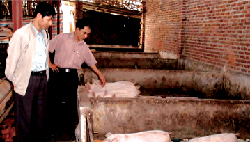
Pork is a food of great economic, cultural and political significance in China. Indeed, the term 'food security' in China's context can be more simply described as 'rice security' + 'pork security'.
Traditionally, rice and pork have been considered economic and political stabilisers for the country and hence ensuring sufficient pork supplies at cheap prices
remains a top national concern, according to the authors in a paper, which was published in an FAO report, 'Asian livestock: Challenges, opportunities and the response', the proceedings of an international policy forum held in Bangkok, Thailand in August 2012.
China is the world's largest hog producer and pork consumer, accounting for almost
half of global pork consumption and production. As can be seen in Figure 1, production
has grown consistently since the implementation of the household responsibility system
in 1978, but recent years have seen fluctuating herd levels and slowing hog production
growth, raising concerns about a sharp increase in pork prices. Although some of the recent
price surges may be attributable to cyclical price and weather variations, some observers
believe that high pork prices are a manifestation of long term underlying structural factors
and increasing resource scarcity - particularly that of land and water.
The Chinese hog
industry is at an important turning point and faces new challenges. In order to put
these developments into context, this paper reviews historical trends in China's hog and pork production
including the factors that contributed to its remarkable growth during the last few decades
and raises some questions about and options for facilitating its future development.
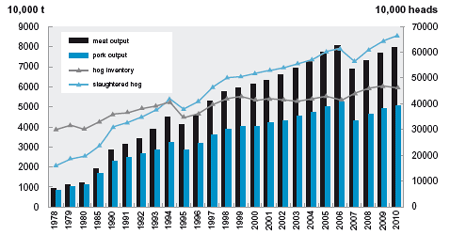
Brief Historical Overview of China's Hog Sector
Pig farming in China has a long history as pork is a traditional meat for the country's Han Chinese population. Although the share of pork in total meat consumption has been declining over time, it still accounts for approximately two-thirds of meat production and consumption in the country. For the purposes of this paper, it is useful to divide the historical overview of pork production into four sub-periods (Wang and Xiao, 2008):
- Reform period (1978-1984): The year 1978 marked the adoption of the household
responsibility system in China, moving away from collective to household-based
farming. The household responsibility system granted pig farmers the powers to
manage their own production and marketing operations. Due to the individual incentives
influencing pig farmers and additional measures instituted by the government, the pig
population grew rapidly and China increased its pig inventories by nearly 30 million pigs
in just two years (1978-1980). Inventories declined between 1980 and 1984 but the
number of pigs slaughtered continued to grow. Between 1978 and 1984, the number
of slaughtered pigs grew at a compound annual growth rate of approximately five per cent
and pork production grew by close to 10 per cent per annum due to additional growth
in productivity.
- Expansionary period (1985-1997): The Communist Party of China's Central Committee
issued '10 policies for stimulating the rural economy'. Among other measures, the policy
favoured the liberalisation of markets and trade over the old system of compulsory
contract purchase. As a result, the pig population and the number of pigs slaughtered
grew very rapidly during this period, raising pig production growth above seven per cent per
annum. Per-capita consumption of pork during this period reached nearly 29kg per
annum.
- Structural adjustment period (1997-2006): Rapid growth during the reform and
expansionary period increased the complexity of operations and the factors that
determined it. In 1997, China faced a structural surplus supply of animal products
accompanied by rising feed and energy prices and growing wage costs for the first time.
In addition, the changing nature of consumer demand brought into focus the demand
for safe and high-quality products. Growing threats in the form of livestock and poultry
diseases and pressures emanating from environmental issues further complicated
the production and marketing environment for the Chinese hog sector. To deal with
these factors, the Chinese Government shifted its focus to promoting improved pig
breeds, improving efficiency and product quality and safety with modern technology,
and addressing the long-term problems of feed scarcity and disease proliferation.
- Industrialisation period (2007 to present): Since the beginning of the industrialisation period, the Chinese hog industry has begun to consolidate its operations and change the mode of future development. New and emerging features of the industry include scaling up, industrialisation and vertical integration. Despite these efficiency-enhancing measures, growth in production has slowed and prices remain stubbornly high and continue to rise. For the first time in decades, China's pig production dropped in 2006 despite the prevalence of relatively high prices. This period has also seen a withdrawal of backyard households from pig breeding and raising operations and a declining share of small-scale producers. These developments point to new challenges for hog production in China and the need for new policy instruments. More important, however, is the growth of production costs due to rising feed prices (Figure 2), which reflects the growing scarcity of key production inputs.
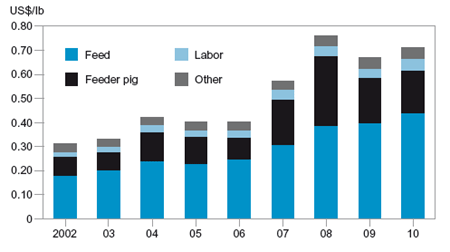
Feed, feeder pig, and labor are three main determinants of hog production costs, accounting for more than 90 per cent of the total production cost. Rising labour and feed costs are largely responsible for the increased production cost.
Source: Gale et al., 2012
Production Costs
Pig farming costs have continued to grow in China, especially since 2006, due to the rising costs of feed and labour. As a result, the profitability of the hog industry has decreased and average hog prices in China have risen considerably higher than those in the United States for the first time, triggering large imports of pork into China. This has raised serious concerns about 'pork security' and the future of the hog industry in China.
Some of the factors that affect the costs and benefits of pig-farming operations include
the global slowdown in grain production and rising energy prices. As feed costs account
for more than 50 per cent of pig production costs, the decline of global cereal output by
approximately 33 million tonnes as well as the diversion of maize for ethanol production led
to soaring food and feed prices. While prices declined in 2008, many of the fundamental
factors prompting higher prices will underpin market fundamentals in the pig sector in China
over the medium to long term.
Epidemics have led to further cost increases associated with losses and animal deaths.
Since the second half of 2006, blue ear pig disease outbreaks in the main pig-producing
areas have greatly affected piglet health and have resulted in piglet shortages. Diseases
have also led to lower slaughtering rates and increased disease prevention costs.
Industrialisation and urbanization further exacerbate pig production costs in China
by pushing up labour costs. As China's industrialization and urbanisation accelerate and
rural-urban migration continues, this trend is likely to continue in the foreseeable future.
The Policy Response
Considering the importance of pork in Chinese diets and its implications for national food security, the Chinese Government has adopted an aggressive policy stance since 2007 with a view to modernising hog production units through vertical integration and scaling up, so as to control quality and reduce costs. Relevant policy instruments involve specific targeted subsidies and tax exemptions, and public systems to monitor hog trends and stabilize prices (Xie 2012). Some specific measures include:
- A sow subsidy started in 2007. The subsidy per sow was 50 yuan in 2005 and
increased to 100 yuan (CNY) per head in 2008. The policy was halted in 2009-2010 and
then resumed in 2011-2012 with the same level of subsidy per head. In 2011, the
total subsidy amount dispensed was about CNY2.6 billion.
- Subsidised insurance for sows and finishing hogs. There is a national coverage
programme for subsidized sow insurance but only a pilot programme for subsidised
insurance for finishing hogs. The coverage per sow is CNY1,000 with a premium
of CNY60. In the Central and Western regions, the central government covers
50 per cent of the premium, while local governments cover 30 per cent. In 2011,
the total subsidy amount dispensed for the sow insurance scheme was about CNY1.4
billion.
- Industrial pig farming funding for major hog-producing counties started in 2007. The
grant can be used for breed improvement, enhancing pig barns, interest subsidies
for production loans and local pig industry development initiatives. From 2007 to
2012, the number of major hog-producing counties benefiting from this support has
increased from 253 to 536, while the total support amount dispensed has grown
from CNY1.5 billion to CNY5.4 billion.
- Grants for larger hog operations. The average grants per farm are CNY200,000 for operations with a total number of slaughtered hogs between 500 and 999, CNY400,000 for operations between 1,000 and 1,999, CNY600,000 for operations between 2,000 and 2,999 and CNY800,000 for operations with a total number of 3,000 and above. The total value of grants dispensed amounted to CNY15 billion for the period 2007-2012.
- Free mandatory immunisation.
- Subsidies for 300 key breeding farms or centres.
- A 25 per cent corporate income tax waiver for pig operations.
- Other promotional measures such as subsidised loans, provision of methane
digesters, assistance in disposal of diseased hogs, grants to returning migrants
to enter into the large-scale hog business, etc.
- Establishment of a national pork reserve system designed to maintain pork reserves for up to seven days of consumption and to support market interventions to stabilize prices by buying pork for reserves when prices are low and sell pork when prices are high (see Table 1 for more detailed information on the relevant intervention guidelines).
Table 1. Intervention guidelines
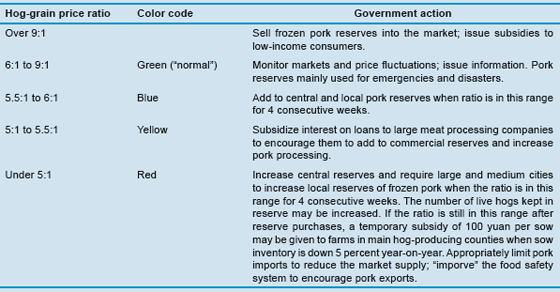
Regional Shifts in Hog Production
China's pig production area consists of six major districts/categories - the middle and lower reaches of the Yangtze River (including Sichuan, Hubei, Hunan, Jianxi, Jiangsu, Zhejiang and Anhui provinces); North China (including Shanxi, Shandong and Henan provinces); Northeast China (including Liaoning, Jilin and Heilongjiang provinces); Southeast China
(including Fujian, Guangdong, Guizhou, and Hainan provinces); municipalities (Beijing,
Tianjin and Shanghai); and other areas (including the remaining 10 provinces).
As can be seen from the data in Table 2, the Yangtze River region's share of hog production has
declined over the years while those of North, Northeast and Southeast China have risen.
Some of this shift has been due to easier access to feed and improved infrastructure. Within
the Yangtze River area however, Sichuan and Hunan remain major producing areas due
to advantages associated with small, miscellaneous grains and land.
North China is primarily a maize- and wheat-producing area, which could facilitate the
region's transformation into a pig production area in the near future. Southeast China has
developed rapidly due to better endowment of resources and market advantages. On the
other hand, the region is at a disadvantage due to increasing environmental awareness and
new pressures to move pig production away from urban areas. In this context, Northeast
China may have some advantages due to its abundance of maize and soybeans and lax
attitude toward environmental concerns.
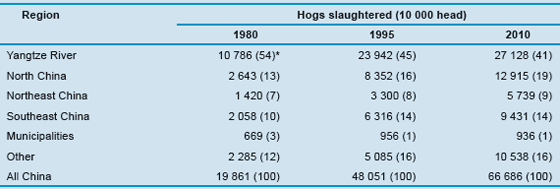
* Figures in parentheses are percentages of total.
Source: National Bureau of Statistics of China (various years)
The Rise of Integrators and Decline of Small-Scale Producers
Another important development in Chinese hog farming pertains to the size of operations and the rapid decline of backyard producers. The share of specialized household production has risen rapidly while large-scale integrated industrial units have also experienced more moderate growth (Figure 3). As can be seen from Table 3, the share of hogs slaughtered on farms with less than 40 pigs declined rapidly from 73 per cent in 2002 to 34 per cent in 2010.
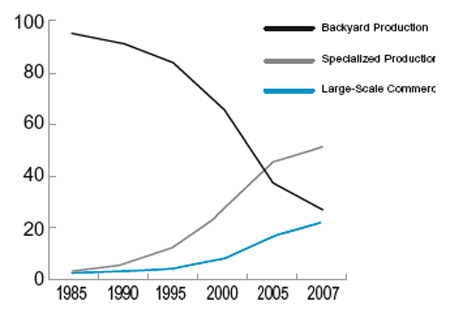

Source: National Bureau of Statistics of China (various years)
In another randomised survey from Zizhong County in Sichuan Province, it was reported that almost 32 per cent of smallholders exited from pig production in just one year due to continuing rural-urban migration, rising wage costs, price volatility and high risk in the hog business due to disease outbreaks (Chen et al. 2012). The Ministry of Agriculture predicts this trend to continue, and that it will be led by large pork production companies in China (Table 4).

Source: National Bureau of Statistics of China (various years)
The leading companies have been partnering with specialized pig households through various organisational models (contracts with farmers, farmer cooperatives, promotion of pig producer associations, etc.) and investing in technology, technical expertise, breeding bases, feed production, etc. Although there is a wide range of organizational models, the general trend is towards scaling up and moving towards integrated companies with control over the entire value chain.
Future Challenges
While the trend in Chinese hog production is towards large-scale integrated units, the question of smallholder market participation remains relevant. The key question is not whether, but how to facilitate the transformation of backyard farms into specialised household farms and how to assist large-scale commercial farms and specialized household farms in integrating backyard farms into mainstream operations.
The policy instruments in that respect would include the provision of technical and advisory services to backyard farms, the development of integrated risk management tools, the promotion of superior breeds and the provision of credit services to alleviate cash flow difficulties faced by small-scale producers.
At the macro level, the government will need to look into ways and means to manage trade more effectively and creating a fair market environment between large and small and domestic and foreign players.
References
Chen, K., Liu, Y., Ruth, H. and Xiao, C. 2012. Can we relax liquidity constraints in microinsurance demand? Piloting an innovative design for agricultural insurance. The final report submitted to ILO Micro-insurance Innovation Facility. July, 2012.
Gale, F., Marti, D. and Hu, D. 2012. China's volatile pork industry. Washington, DC, United States Department of Agriculture, Economic Research Service.
National Bureau of Statistics of China. Various years. Livestock statistical yearbook of China. Beijing, Chinese Agriculture Publishing House.
Schneider, M. 2011. Feeding China's pigs implications for the environment, China's smallholder farmers and food security. Ithaca and Beijing, Institute for Agriculture and Trade Policy and Mindi Schneider.
Wang, Jimin and Xiao, Hongbo. 2008. Development of the hog industry and its integration in China. In Jimin Wang and Mariko Watanabe, eds. Pork production in China - a survey and analysis of the industry at a Lewis turning point. ASEDP, Institute of Developing Economies, Japan External Trade Organization.
Xie, Shuanghong. 2012. Chinese animal husbandry in 2012: Development and policy focus. Guide to Chinese Poultry, Issue 17, 2012.
February 2013








